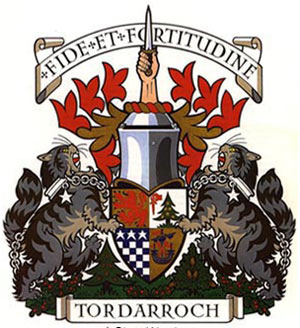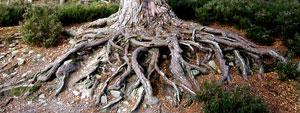
Since the dawn of humankind, our ancestors' inherit links to the environment go well beyond the obvious physical and tangible aspects necessary for mere survival. Whether as nomadic hunter, gatherer or from pastoral/agrarian family groupings, each primitive clan or tribe also had many strong spiritual and emotional links to the earth and nature. One consistent aspect of this earth oriented "reverence" is evidenced in all tribal cultures both ancient and modern throughout the world by the adoption of significant animals or plants as symbols or totems. It was felt that some of the beneficial, powerful or protective properties of the adopted item would shamanistically flow into the individual person or collective clan entity. This ethos was quite strongly established in ancient Eire and Pictish Alba well before medieval feudalism and its armoral necessities of heraldic science became established in the mid 1100s. Since then, the inclusive, communal tribal ethos that all are equal, related with, of, to, and by the land, the clan and its leaders have continued to remain quite strong in Scottish heraldic law. All clansfolks Arms closely echo the Arms of the Head of the Name, Clan or Sept. (This was quite different than the more stratified and class divided English Heraldic Law).
There are four main totemic symbols of significance that are found in most Shaw Arms registered in the Court of the Lord Lyon, King of Arms for Scotland, the ancient heraldic court of Alba:
Lyon Rampant
The ancient totemic symbol of the semi-pagan Ulidian Kings of Dal Riada in Antrim, Eire and later in Argyle. This remained as the symbol of the High Kings of Alba/Scotland, and remains quartered in the Arms of H.R.M. Based on our descent from the royal line of Dal Riadic/Scottish Kings to the great Mac Duff Kings (later Earls) of Fife through our Mackintosh forbearers it is proudly quartered in all Highland Mackintosh, Shaw and Farquharson Arms.
Fir Tree on a Mound
This represents Rothiemurchus Forest, the original tribal homeland of all branches of Clan Shaw. It was held firstly by our Mackintosh forefathers since 1236 but through the efforts of Shaw Mhor in 1396 and especially his grandson Alasdair Ciar Mackintosh in 1464, it was eventually held in Thanage, direct from the King of Scots. Rothiemurchus was rich in fertile Speyside farmlands and timber resources as well as being in a strategic geopolitical position. The 'mound' is also thought to represent The Doune of Rothiemurchus, the ancient timbered hill-fort once occupied by our ancestors, that guards a strategic ford over the oft flooded Spey. The Doune is now held by the Clan Grant Chiefs (as well as the Bodach an Doune).
Dagger
The red dagger is by legend said to represent the instrument of the death blow struck in a wild ambush against the Chief of the Altyre branch of Clan Comyn at Lag na Cuimeanach, ten miles north of Rothiemurchus. This battle took place circa 1430 or so with the dagger wielded by Alasdair Ciar Mackintosh, Chief of Clan Shaw, or perhaps his younger brother, Ay Macintosh, founder of Clan Ay, the Shaws of Tordarroch. The Mackintosh Shaw victory at Lag na Cuirnmmenach swept the Comyns from Rothiemurchus forever. In most Celtic legends, the dagger upraised is portrayed as a symbol of male fertility.
Galley
Originally a crescent moon symbol representing the Norse female fertility/earth goddess Nerthus, the Galley is also a Gaelic Lymphad or longship. This is based on both Irish and Norse pre-feudal heraldry, and is found mostly in clans with origins or allegiances by blood, tanistry or sacred oath to Gaelic/Norse west coast or Hebridean clans, primarily of the descent from the MacDonald Kings or Sub-Regulus of the Isles. In its form as a blue lymphad, this is a symbol of the Clan Chattan tribal confederation, which was loosely allied with the great Clan Donald. Other Shaw armoral/totemic symbols include a blue and white chequered field with three with mullets (stars), a red hand holding a heart, a boar or wolf's head, and a salmon.
There are four main totemic symbols of significance that are found in most Shaw Arms registered in the Court of the Lord Lyon, King of Arms for Scotland, the ancient heraldic court of Alba:
Lyon Rampant
The ancient totemic symbol of the semi-
Fir Tree on a Mound
This represents Rothiemurchus Forest, the original tribal homeland of all branches of Clan Shaw. It was held firstly by our Mackintosh forefathers since 1236 but through the efforts of Shaw Mhor in 1396 and especially his grandson Alasdair Ciar Mackintosh in 1464, it was eventually held in Thanage, direct from the King of Scots. Rothiemurchus was rich in fertile Speyside farmlands and timber resources as well as being in a strategic geopolitical position. The 'mound' is also thought to represent The Doune of Rothiemurchus, the ancient timbered hill-
Dagger
The red dagger is by legend said to represent the instrument of the death blow struck in a wild ambush against the Chief of the Altyre branch of Clan Comyn at Lag na Cuimeanach, ten miles north of Rothiemurchus. This battle took place circa 1430 or so with the dagger wielded by Alasdair Ciar Mackintosh, Chief of Clan Shaw, or perhaps his younger brother, Ay Macintosh, founder of Clan Ay, the Shaws of Tordarroch. The Mackintosh Shaw victory at Lag na Cuirnmmenach swept the Comyns from Rothiemurchus forever. In most Celtic legends, the dagger upraised is portrayed as a symbol of male fertility.
Galley
Originally a crescent moon symbol representing the Norse female fertility/earth goddess Nerthus, the Galley is also a Gaelic Lymphad or longship. This is based on both Irish and Norse pre-
HERALDRY & TRIBAL TOTEMS




Red Whortleberry
(Vaccinum vitus-idea) is the Suaicheantas or Plant Badge of the Highland Family and indeed most of the clans of the Clan Chattan confederation of tribes. The Whortleberry, or lus nam braoileag, comes down to us from the badge of the ancient Clan Duff. In both Scotland of the old and today, what clan you belonged to is indicated by what plant you wear in your bonnet or cloghaid (conical helmet). This continuing tradition of having a venerated or lucky clan plant symbol or badge again goes back to the early Dawn Religions that held that certain plants contained a stronger essence or lucky spirit. Strongly connected with the environment, in mind, body and soul, our ancestors felt the tribal spirit was enhanced by a near worship of the sacred or lucky plant or tree.
Crests
Both the hand holding a dagger and the demi-Lyon rampant holding a sword aloft have been used in Shaw armoral crests. The dagger has been used primarily in the Arms of Tordarroch/Clan Ay line, while the Lyon is commemorative to the Mackintosh Shaw Thanes of Rothiemurchus. The demi-Lyon is also found in Farquharson and various Shaw of Crathienaird/Glenshee Arms. Since the 1970 matriculation of Arms of the Chief of Clan Shaw, the dagger upraised has been used as the armoral symbol in the basic Clan Shaw 'strap and buckle' crests. Below the crest should always read: "An Cireann Ceann Cinnidh", i.e., The Crest of the Chief.
(Vaccinum vitus-
Crests
Both the hand holding a dagger and the demi-

All written content copyrighted by William G.A. Shaw of Easter Lair ~ May 2000/March 2008. No part of this website can be used in entirety or in part or in reference or in paraphrase without proper credit to the author, or if republished,
without prior permission of the author.
without prior permission of the author.
A Stern Warning: This is the personal Arms and Property of the Chief of Clan Shaw, and is not to be used by anyone other than the Chief of Clan Shaw, under penalty of Scottish Law and good taste

A Stern Warning: This is the personal Arms and Property of William Shaw of Easter Lair, and is not to be used by anyone other than he, under penalty of Scottish Law and good taste